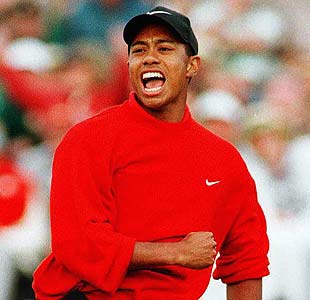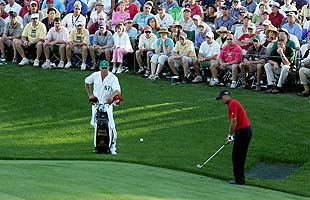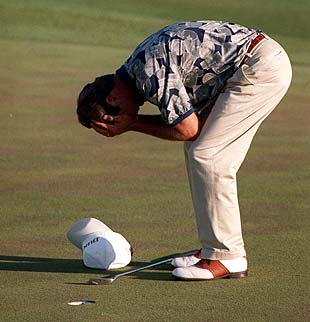#1 1986 Masters: Jack Nicklaus
12,942 votes

Jack Nicklaus shoots a back-nine 30 for a final-round 65 and a one-shot win over
Tom Kite and
Greg Norman.
(David Cannon/Getty images)
The most memorable part of the 1986 Masters wasn’t the shot-making itself; it was the Sunday roars reverberating through Augusta National every time Jack Nicklaus sank another birdie or eagle putt.
Other golfers could only pause between shots waiting for the din to die down. Nicklaus, 46, kept plodding along, feeding off the cheers and shooting an astonishing back-nine 30 for a 65 to win by one and claim a record sixth Masters title.
“That was special for me and special I suppose for the golfing world in so many ways because they just didn’t expect that to happen,” Nicklaus said.
There wasn’t one shot that won it for the Golden Bear there were several, and not all of his own doing.
There was his eagle at 15 after hitting 4-iron to 15 feet; the short birdie putt at 16 after nearly holing his tee shot; the double-breaking birdie putt he drained at 17 to take the lead; and the long lag putt at 18 that left him a tap-in for par.
Playing behind Nicklaus, Seve Ballesteros had led by two going to 15 before chunking his approach into the water for the first of two late bogeys. At 18, Tom Kite, down one, hit a 6-iron that released nicely to within 12 feet of the hole. But his birdie putt to tie lost speed and slid past the cup’s left edge.
The last to challenge Jack was third-round leader Greg Norman, who birdied 14, 15, 16 and 17 to catch Nicklaus at nine under, only to fall apart at 18. The Shark inexplicably blocked his second shot well right into the crowd, then was unable to get up and down for a par that would have forced a playoff for the ages.
“The reality of it all was that going into the back nine, Jack was not even a factor in most of our minds,” Kite says. “The competition was between Seve, Greg and myself, and I’m pretty sure we all thought the winner would come from those three.”
They thought wrong.

Tiger Woods wins his first professional major, blowing away the field with a record 18-under 270 that leaves him 12 shots clear of runner-up Tom Kite.
(Getty Images)
Tiger Woods’ first Masters as a professional appeared a disaster in the making from the start. In Thursday’s first round, he went out in 40, hinting he might have trouble breaking 80.
Silly us: He went on to break tournament records.
At 21, Woods gave a clinic in first-class world beating, shooting 30 on Thursday’s back nine, taking a three-shot lead with a 66 on Friday, then blowing away the field with weekend rounds of 65 and 69. That gave him a tournament-record 270 total and a record 12-shot margin of victory over, if anybody noticed, Tom Kite.
Over the last 63 holes, Woods was 22 under par.
Equally amazing was the murderer’s row of golfers, one by one, who fizzled each day while paired with Woods. Three-time Masters winner Nick Faldo stumbled to an opening 75 before eventually missing the cut with a second-round 81. Friday’s victim was Paul Azinger, who followed a 69 with a Tiger-accompanied 73 on Friday.
“He never had a mental lapse out there,” Azinger said of Woods. “I just got out-concentrated.”
Ditto the Tiger treatment on Saturday for Colin Montgomerie (74 – and an 81 a day later) and, finally, European Ryder Cup hero Costantino Rocca (75) on Sunday, when Woods brought out the trademark bulletproof red shirt.
The only final-round suspense came when Woods, needing a par at 18 to break the Masters scoring record of 271, yanked his drive far left. No problem: He recovered with an approach to 20 feet and a two-putt par.
“Of course he was in the zone,” says Kite, who would never win a Masters although he was runner-up in the two most memorable. “I heard he went the entire week and never had a three-putt. That is almost unheard-of.”
#3 2005: Tiger Woods
6,937 votes

Woods’ back-down-the-slope chip-in at 16 sets the stage as he goes on to beat Chris DiMarco in a playoff for his fourth green jacket.
(Getty Images)
Start with that preposterous chip-in at 16 in Sunday’s fourth round.
You remember, the one which Tiger Woods skipped well past the hole before the ball took a right turn and reversed course, trickled back down the slope and paused teasingly on the lip before tumbling into the cup for a birdie. How can you forget? It remains the Masters TV highlight that won’t go away.
But this was no one-shot tournament. Another look at the big picture recalls the drama that unfolded over the last 37 holes after Chris DiMarco had bolted to a Normanian six-shot lead through 36 holes with a pair of 67s.
In a third round that started late Saturday and spilled over into Sunday, Woods mounted his expected charge, shooting a 65 that included a string of seven straight birdies. Meanwhile, DiMarco performed the obligatory Woods-induced pratfall, posting an ugly 74 that left him three back.
Only, DiMarco didn’t go away. In the fourth round on Sunday, he gradually climbed back to within one of the lead before Woods pulled the string on that improbable chip-in birdie at 16.
“You expect the unexpected, and, unfortunately, it’s not unexpected when he’s doing it,” said DiMarco, who still wasn’t done.
Up two, Woods pulled off another unexpected stunt. He gagged. He bogeyed 17 and 18, giving DiMarco one more opening. DiMarco’s birdie chip to win at 18 grazed the hole’s edge before he made the six-foot par putt to force a playoff. No one else was closer than seven shots.
On the first hole of the playoff, at 18, Woods closed out DiMarco with a 15-foot birdie putt for his fourth green jacket and first without his dad Earl, at home battling cancer, on hand.
“This is for Dad,” a crying Woods said at the green jacket ceremony. “Every year I’ve been lucky enough to win this tournament, my dad has been there to give me a hug. I can’t wait to get back to the house and give him a big bear hug.”
#4 1996: Nick Faldo
5,081 votes

Greg Norman blows a six-shot lead while playing partner Faldo closes with a 67 to win by five.
(AP Photo/Dave Martin)
For a half-century, the Masters Tournament has thrived as must-see TV. Golfing entertainment fit for the entire family. In 1996, it got its first PG rating: Poor Greg.
It was a train wreck in slow motion. It was Bill Buckner muffing 18 straight groundballs. It was Greg Norman shooting an opening 63 to tie his buddy Nick Price’s tournament low-round record and eventually building a six-shot lead, before frittering it away on Sunday in an almost unbearable-to-watch meltdown.
Let’s not shortchange Nick Faldo, though. His brilliant five-under 67 was Sunday’s low round and gave him his third green jacket. In winning three times at Augusta, the relentless Faldo had overcome final-round deficits of three, five and, now, six shots.
Six shots. That’s the supposedly insurmountable lead Norman clutched going into his expected Sunday coronation. Cue the locomotive. A hooked drive at No. 1 led to one bogey.
Subsequent bogeys at 4 and 9 followed. At the ninth, the Shark hit the green six feet short of the flag before his ball retreated off the green and down the hill, back into the fairway.
Worse yet was the stretch at 10-12 in which the obviously shaken Norman lost four more strokes to par, leaving him two shots arrears of the devastatingly methodical Faldo. At one point Price, watching this funeral march on TV, bolted the clubhouse and headed to his car, saying, “I can’t stand to watch.”
Few could. By day’s end, Norman had carved out a 78, his unwitting contribution to an 11-shot swing that gave Faldo the five-stroke win.
After both had putted out at 18, Faldo gave Norman a conciliatory hug. Both men had tears in their eyes as Faldo told his rival, “I don’t know what to say. I just want to give you a hug. I feel horrible about what happened. I’m so sorry.”
#5 1995: Ben Crenshaw
4,528 votes

One week after the death of his mentor Harvey Penick, Ben Crenshaw birdies 16 and 17 and bends over sobbing after putting out at 18 to record a one-shot victory over Davis Love III.
(AP Photo/Ed Reinke)
Ben Crenshaw winning the Masters is no big surprise. He always has been a good fit for Augusta. Start with his magical putter for those undulating greens, the absence of rough for when shots go awry, and his scholarly reverence for traditional courses and the game’s rich history. In fact, he had already won there in 1984.
The down side for Crenshaw in 1995 was that he hadn’t broken 70 in two months, had missed three of the last four cuts and, unfathomable for him, was ranked 69th on tour in putting. And, oh yeah, his longtime mentor and confidant Harvey Penick, 90, had just passed away.
On Tuesday, Crenshaw received a putting-epiphany tip from caddie Carl Edwards. On Wednesday, he flew in a downpour to Austin, Texas, for Penick’s funeral and then flew right back, arriving in Augusta Wednesday evening emotionally spent and drained of energy.
On Thursday, Crenshaw arose a changed man, about to embark on a four-day stroll to destiny unlike any before.
“I just had this strong feeling the whole week,” Crenshaw said. “I never had a week like this, where I really enjoyed playing golf the whole week.”
Rounds of 70, 67 and 69 put Crenshaw in a tie for the lead with Brian Henninger at 10 under going into Sunday. Still, a bunch of big guns lurked within three shots of the lead, including Fred Couples, Curtis Strange, Phil Mickelson, Jay Haas, Steve Elkington, Scott Hoch, Greg Norman and Davis Love III.
With Penick apparently lighting the way, Crenshaw persevered while others stumbled. On his way to a closing 68, Crenshaw birdied 16 and 17 for a two-shot cushion, then went ultra-conservative with a careful bogey at 18 for a one-shot win over Love.
As soon as his winning putt dropped, Crenshaw bent over at the waist, put his face in his hands and sobbed while Jackson consoled him.
“I believe in fate,” Crenshaw said. “I don’t know how it happened. I don’t.”
Original here

 Jack Nicklaus shoots a back-nine 30 for a final-round 65 and a one-shot win over
Jack Nicklaus shoots a back-nine 30 for a final-round 65 and a one-shot win over  Tiger Woods wins his first professional major, blowing away the field with a record 18-under 270 that leaves him 12 shots clear of runner-up Tom Kite.
Tiger Woods wins his first professional major, blowing away the field with a record 18-under 270 that leaves him 12 shots clear of runner-up Tom Kite.  Woods’ back-down-the-slope chip-in at 16 sets the stage as he goes on to beat Chris DiMarco in a playoff for his fourth green jacket.
Woods’ back-down-the-slope chip-in at 16 sets the stage as he goes on to beat Chris DiMarco in a playoff for his fourth green jacket.  Greg Norman blows a six-shot lead while playing partner Faldo closes with a 67 to win by five.
Greg Norman blows a six-shot lead while playing partner Faldo closes with a 67 to win by five.  One week after the death of his mentor Harvey Penick, Ben Crenshaw birdies 16 and 17 and bends over sobbing after putting out at 18 to record a one-shot victory over Davis Love III.
One week after the death of his mentor Harvey Penick, Ben Crenshaw birdies 16 and 17 and bends over sobbing after putting out at 18 to record a one-shot victory over Davis Love III. 